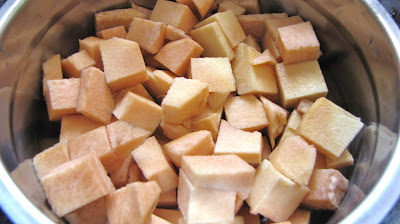Elephant yam that is called senai kizhangu or karunai kizhangu in
Tamil is usually preferred as fry. Elephant yam is low in glycaemic index and
rich in omega 3 fatty acids while it renders a very cooling effect to the body.
I had cooked ‘masiyal’ which is like a chutney variety; I slightly modified
this recipe which is an inspiration from kamalascorner.com on the flow just for
convenience.
Serves: 2
Preparation Time: 15 min
Cooking Time: 15 min
Ingredients:
1. Elephant yam – 1 cup chopped
2. Shallots or Madras onion – 5
3. Tamarind – 5” long strip or 2
tbsp pulp
4. Salt to taste
5. Oil – ½ tbsp.
6. Sambar powder – ½ tbsp.
7. Mustard seeds – ½ tsp.
8. Urad dal – ½ tbsp.
9. Asafoetida – 1 pinch
10. Curry leaves – 1 sprig
Method:
Step 1: Wash, peel and chop yam roughly; steam
cook it with salt.
Step 2: Sauté shallots in few drops of oil.
Step 3: Grind boiled yam, shallots, soaked
tamarind or its pulp with enough salt into a thin paste.
Step 4: Heat a pan and prepare tempering by:
spluttering mustard seeds, frying urad dal, sprinkling asafoetida and adding
curry leaves.
Step 5: To it add the ground paste and sambar
powder and stir well.
Step 6: Once you see bubbles in it and the raw
smell goes, switch off the stove and transfer to serving bowl.
Step 7: Serve with hot steamed rice drizzled
with ghee.
TIPS:
*My mom adds red chili to tadka and avoids
sambar powder so that no double cooking is required.
*You can sauté the chopped onion in tempering
and just mash the cooked yam with the help of masher so that no mixer is
required to grind.












